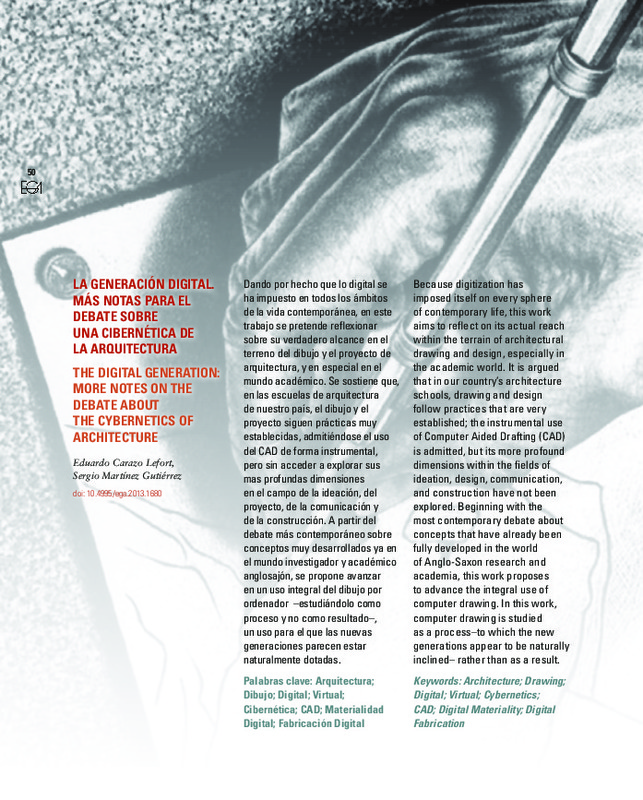JavaScript is disabled for your browser. Some features of this site may not work without it.
Buscar en RiuNet
Listar
Mi cuenta
Estadísticas
Ayuda RiuNet
Admin. UPV
La generación digital. Más notas para el debate sobre una cibernética de la arquitectura
Mostrar el registro sencillo del ítem
Ficheros en el ítem
| dc.contributor.author | Carazo Lefort, Eduardo
|
es_ES |
| dc.contributor.author | Martínez Gutiérrez, Sergio
|
es_ES |
| dc.date.accessioned | 2016-12-23T11:25:32Z | |
| dc.date.available | 2016-12-23T11:25:32Z | |
| dc.date.issued | 2013-11-06 | |
| dc.identifier.issn | 1133-6137 | |
| dc.identifier.uri | http://hdl.handle.net/10251/75722 | |
| dc.description.abstract | [EN] Because digitization has imposed itself on every sphere of contemporary life, this work aims to reflect on its actual reach within the terrain of architectural drawing and design, especially in the academic world. It is argued that in our country’s architecture schools, drawing and design follow practices that are very established; the instrumental use of Computer Aided Drafting (CAD) is admitted, but its more profound dimensions within the fields of ideation, design, communication, and construction have not been explored. Beginning with the most contemporary debate about concepts that have already been fully developed in the world of Anglo-Saxon research and academia, this work proposes to advance the integral use of computer drawing. In this work, computer drawing is studied as a process–to which the new generations appear to be naturally inclined– rather than as a result | es_ES |
| dc.description.abstract | [ES] Dando por hecho que lo digital se ha impuesto en todos los ámbitos de la vida contemporánea, en este trabajo se pretende reflexionar sobre su verdadero alcance en el terreno del dibujo y el proyecto de arquitectura, y en especial en el mundo académico. Se sostiene que, en las escuelas de arquitectura de nuestro país, el dibujo y el proyecto siguen prácticas muy establecidas, admitiéndose el uso del CAD de forma instrumental, pero sin acceder a explorar sus mas profundas dimensiones en el campo de la ideación, del proyecto, de la comunicación y de la construcción. A partir del debate más contemporáneo sobre conceptos muy desarrollados ya en el mundo investigador y académico anglosajón, se propone avanzar en un uso integral del dibujo por ordenador –estudiándolo como proceso y no como resultado–, un uso para el que las nuevas generaciones parecen estar naturalmente dotadas. | es_ES |
| dc.language | Español | es_ES |
| dc.language | Inglés | es_ES |
| dc.publisher | Universitat Politècnica de València | |
| dc.relation.ispartof | EGA. Revista de Expresión Gráfica Arquitectónica | |
| dc.rights | Reserva de todos los derechos | es_ES |
| dc.subject | Arquitectura | es_ES |
| dc.subject | Dibujo | es_ES |
| dc.subject | Digital | es_ES |
| dc.subject | Virtual | es_ES |
| dc.subject | Cibernética | es_ES |
| dc.subject | CAD | es_ES |
| dc.subject | Materialidad Digital | es_ES |
| dc.subject | Fabricación Digital | es_ES |
| dc.title | La generación digital. Más notas para el debate sobre una cibernética de la arquitectura | es_ES |
| dc.title.alternative | THE DIGITAL GENERATION: MORE NOTES ON THE DEBATE ABOUT THE CYBERNETICS OF ARCHITECTURE | es_ES |
| dc.type | Artículo | es_ES |
| dc.date.updated | 2016-12-23T08:42:02Z | |
| dc.identifier.doi | 10.4995/ega.2013.1680 | |
| dc.rights.accessRights | Abierto | es_ES |
| dc.description.bibliographicCitation | Carazo Lefort, E.; Martínez Gutiérrez, S. (2013). La generación digital. Más notas para el debate sobre una cibernética de la arquitectura. EGA. Revista de Expresión Gráfica Arquitectónica. 18(22):50-59. https://doi.org/10.4995/ega.2013.1680 | es_ES |
| dc.description.accrualMethod | SWORD | es_ES |
| dc.relation.publisherversion | https://doi.org/10.4995/ega.2013.1680 | es_ES |
| dc.description.upvformatpinicio | 50 | es_ES |
| dc.description.upvformatpfin | 59 | es_ES |
| dc.type.version | info:eu-repo/semantics/publishedVersion | es_ES |
| dc.description.volume | 18 | |
| dc.description.issue | 22 | |
| dc.identifier.eissn | 2254-6103 |








